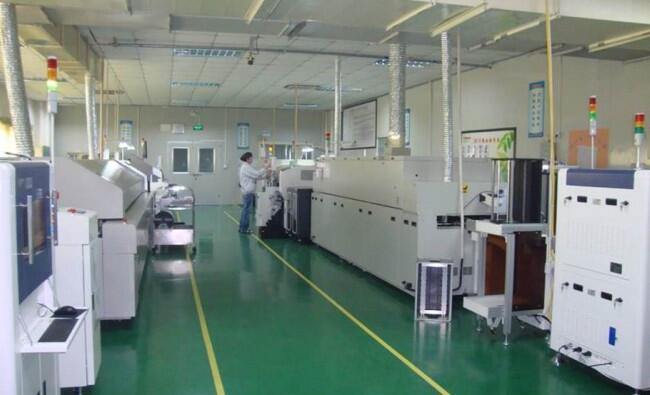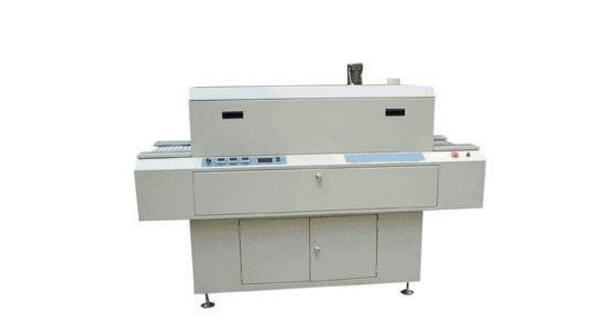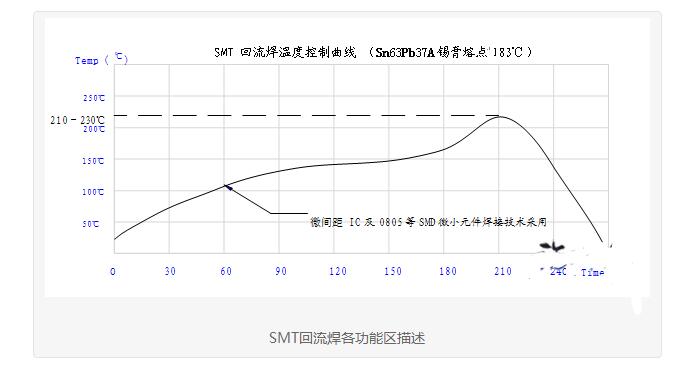The reflow soldering machine, also called reflow soldering machine, is a device that provides a heating environment to melt the solder paste so that the surface mounted components and the PCB pads can be reliably bonded together through the solder paste alloy. The reflow soldering machine consists of a control system (control system uses PC+PLC+HMI (Human Machine Interface) mode), hot air system (supercharged forced circulation hot air heating system, back and forth air return, to prevent the effect of temperature interval air flow, ensuring temperature uniformity and Heating efficiency; special high-temperature motor, variable frequency adjustable), cold air system (forced air-cooled and water-cooled structure, cooling zone temperature display adjustable), body, transmission system. The maintenance work that we must do after using reflow soldering; otherwise it is difficult to maintain the service life of the equipment. 1, daily inspection of the various parts, pay special attention to the transmission belt, can not make it stuck or fall off 2. When the machine is inspected, it should be turned off and cut off to prevent electric shock or short circuit. 3, the machine must be stable, not inclined or unstable 4. In the event that heating is stopped in an individual temperature zone, the corresponding fuse should be checked first by re-melting the paste that was pre-allocated to the PCB pad. 1. The reflow welding heat transfer system must have 4 to 5 heating zones At least in the reheat zone reflow zone should be provided with a lower heater, and can independently control the temperature, to ensure that the temperature can be quickly transferred to the welding temperature in three ways: conduction, radiation, convection. 2, the type of heater Generally can be divided into two categories, one is the infrared lamp and adapt to lamp heaters, they can directly radiate heat, also known as a primary radiator; the other is a ceramic plate, aluminum plate and stainless steel plate heater. Tubular heater: It has the advantages of high working temperature, short wavelength of radiation and correspondingly fast heat, but due to the generation of light when heated, it has different reflection effect on components with different colors, and it is also not conducive to compulsory Hot air support. Plate heater: slow thermal response, low efficiency, but due to large thermal inertia, through the perforation is conducive to the heating of the hot air, the sensitivity of the color in the welded component is small, the shadow effect is small, in addition, the current reflow welding In the furnace, the heaters are almost all aluminum or stainless steel heaters. 3, furnace temperature evaluation The evaluation of the temperature of the re-flow furnace is an important part of the selection of the re-flow furnace and is usually evaluated by the following methods: (1) Uniform temperature across the cross section of the chamber The re-flow furnace orbit to the maximum position, place a pcb, and pcb along the cross-section of the furnace to set 5 to 6 test points, measured when the temperature difference between the board surface, the temperature difference should be less than 0.5 degrees Celsius. Then continuously put pcb (full load), measure the temperature of the last pcb board surface (same as the first block), in order to determine the temperature difference on pcb at full load, generally around plus or minus 1 degree Celsius. The third step is to place different analog IC blocks on the pcb before testing. This kind of judgment can effectively see the temperature change of the reflow furnace at full load, and at the same time, observe the actual temperature change shown on the reflow furnace table, which should normally not exceed plus or minus 1 degree Celsius. (2) Resolution of furnace vertical (moving direction) temperature If you take a 20cm*20cm pcb, place it on three thermocouples and test the oven temperature profile. The measured temperature profile should clearly reflect the misalignment of the thermocouple on the pcb, ie, the thermocouple in the front (movement direction) reaches the high temperature zone first, and then reaches the high temperature zone with a clear hierarchy. 4, reflow furnace insulation performance A good reflow furnace has good thermal insulation performance and high thermal efficiency. The poor reflow furnace insulation performance cannot meet the requirements. Although it is difficult to measure the thermal efficiency of the furnace, it can be determined by touching the reflow furnace and the exhaust pipe when the shell is in operation. Usually, this is a heat-dissipating area. When the hand is touched and you feel hot or afraid to touch it, it means the furnace. The thermal insulation performance is poor, and the energy consumption is large. Normally, the human hand feels slightly warm (about 50 degrees Celsius). 5, transmission system There are three types of reflow furnace delivery systems: (1) Heat-resistant PTFE glass fiber cloth is only suitable for small-sized and hot plate infrared heating type reflow furnace (2) Stainless steel mesh is not suitable for welding double-sided PCB (3) General method of chain guides 6. Forced convective wind speed Forced convection can be used to make the temperature of the furnace chamber uniform, but it can not achieve the displacement of components. Generally, a 0402 element is placed on the PCB (no solder paste is printed), and then the position of the furnace is observed through the reflow furnace. Variety. With this method, it is also possible to determine the smoothness of the orbital motion and the wind speed of the hot air, and the wind speed cannot cause displacement of components. 7, the control system The choice of reflow control system should be based on the conditions of the large production and the cost. For large-scale OEM and other processing centers, the use of high-end control systems is advantageous, such as PROFILER temperature measurement device, a system can realize the control of multiple reflow furnaces, which can realize the furnace temperature management of multiple production lines. 8, cooling system When SMA welding is a component of reflow after cooling, the cooling function of the nitrogen reflow furnace is a bit air-cooled (nitrogen or air), one of which is the same as the cooling water, which accelerates the cooling of the overheated SMA. 9, nitrogen protection system The mechanism of nitrogen reflow protection reflow oven is the same as that of nitrogen protection wave soldering. Reflow soldering should be considered as the “sealing capabilityâ€. Nitrogen reflow furnaces usually use nitrogen “wind curtains†to achieve the seal of the way in and out. 10. Reflow furnace size choice In general products, there are five temperature zones in the reflow furnace, and the width of the guide rail should be larger than the PCB to be processed (the objectively processed PCB size is much smaller than the track width of the reflow welder). Large reflow furnaces can have as many as 9 or 11 temperature zones, with multiple temperature zones, and the operating curve can be easily adjusted. The production capacity is large, but the cost and the space are also large. In addition, the inlet height of the reflow furnace should also be considered, especially when the furnace temperature tester is selected, whether the tester can be easily entered. 1 Close the device's main power supply (air panel in the lower left of the machine). Turn on the floor exhaust ventilation system switch to make it work normally. 2 Press the POWER button on the top right of the machine, turn on the computer, log in the reflow system interface, confirm that the system communication is normal, and call the lead-free solder paste reflow procedure. Check the set of eight heating temperature target temperature value (leaded) SV should be followed by: 165,160,175,185,190,190,240,200. The conveyor belt speed should be 75cm ± 10cm/min. 3 Click the total start button on the reflow control software interface to close the wind, conveyor, heating, and cooling switches so that the machine is in operation. 4 After the cold machine is to be warmed up for 20 to 30 minutes, observe whether the actual temperature PV and the set value SV are stable in the window. If yes, proceed to the next step. No: reset the PID parameter value of the temperature control table, and After 10 minutes, check whether the stabilization is performed again. The calibration is performed by the technician. 1 The thermometer and its 3 probes are placed on a test board of the same size as the workpiece PCB, and the furnace temperature is measured with the conveyor belt. After the furnace is released, the temperature is read out on the PC temperature software. The actual temperature of the board at the time. 2 Compare the actual measurement result from the previous step with the left standard curve. If the test curve is the same as or similar to the standard curve, you can start normal production; otherwise, try to set the SV value again on the temperature control table with large temperature difference from the standard curve. (Increase or decrease with a gradient of about 5 °C), or with the transmission belt operating speed to comprehensively adjust, in order to achieve the workpiece temperature control curve required for actual production. Zone 1 - Preheat Zone Zone 2 - Preheat Zone Zone 3 - Preheat Zone Zone 4 - Dry Zone Zone 5 - Dry Zone Zone 6 - Zone 7 Zone - Welding zone 8 temperature zone - rapid cooling zone The first temperature zone—165±2°C The second temperature zone—160±2°C The third temperature zone—175±2°C The fourth temperature zone—185±2°C The fifth temperature zone—190±2°C The sixth temperature zone— 190 ±2°C Seventh temperature zone -240±2°C Eighth temperature zone -200 ±2°C 9th temperature zone - room temperature air-cooled zone 1. Set the main control value - Move the mouse to the reflow oven control software HMI main screen. Reflow oven corresponding to the desired temperature zone value within the window area, click, and enter the desired "SV" on the pop-up home keypad. Set the value; press "OK" to save and exit. Set the value range "0~399". 2. Set PID parameters - Select the "Settings" menu option in the reflow oven control software HMI main screen, click the "Password" option in the pull-down menu, and enter the required "user name, password" in the pop-up screen. After confirming that the operator is a legal person (full-time engineering technician), you can start to enter the PID parameter settings: Click in the pop-up oven's corresponding upper and lower temperature window's value window area, and enter the required number on the pop-up home keypad. P (or I) parameter setting value; press "OK" key to save and exit. Set the value range "0~399". 1, welding components in the welding process should not be due to vibration and shift, skew, erect. 2, PCB components reflow process time should be controlled within 3 to 5 minutes. 3, solder paste flow is good. After welding, the board solder joints should be bright and uniform, and the solder wetted pad and component leads should be uniform. 4, no PCB discoloration, copper foil warping, falling off and other undesirable phenomena. 1, under normal conditions: 1 Check if the PCB in the reflow machine is completely soldered. 2 Turn off the heating, wait for 20 to 30 minutes, point to start, turn off the wind, transport, heating, cooling switch, turn off the computer. 3 or use automatic delay shutdown mode, direct point automatic shutdown button. 4 Turn off the device mains power (bottom left of the back of the machine). 2, in an emergency: 1 Press the EMERGENT STOP switch on the left side of the machine. 2 Turn off the device main power (bottom left of the back of the machine). 1. The setting of the temperature zone can not be arbitrarily adjusted. The parameters of the above temperature zone are basically determined according to the actual curing effect of the welding PCB area accounting for 90% of the effective area of ​​the welding furnace transmission steel net and the running speed of 75cm±10cm/S. of. When the area of ​​the pcb board to be processed is larger and smaller, the tape speed should be fine-tuned to achieve a good welding effect. The general principle of adjustment is: pcb board area is small, the net take away speed is slightly faster, pcb board area is large, the network belt takes a little slower speed, everything in order to achieve good welding results prevail. 2. The PID parameters of the temperature control table must not be set arbitrarily. 3. During the use of the inlet and outlet of the reflow soldering machine, the external natural wind should be avoided to affect the dynamic temperature balance in the furnace and affect the welding quality. 4. When the PCB workpiece at the outlet of the reflow oven is sent out, it is necessary to avoid the occurrence of accidents caused by the scald operator; also to prevent the PCB board from accumulating at the discharge port, causing the PCB board to fall or exit the PCB board at high temperature solder strength Low SMD components fall off due to crash or impact. 5. Do a good job in the daily maintenance of the welder's equipment: clean the surface of the equipment daily to keep it free from contamination. In the manual mode, click the oil button once a week to lubricate the chain with high-temperature lubricant (BIO-30); No less than twice per month: Check to add high-temperature lubricant to the furnace motor and each rotating shaft. 6. Before starting the machine every day, check that the ground wire of the welder is connected reliably. 7. After troubleshooting, close the device's main power supply and turn the red mushroom-shaped emergency stop switch clockwise to return to the original working state. When shutting down, do not allow the PCB and the transmission steel mesh belt to stop in the furnace which is still in a high temperature state, and stop the conveyor belt after the internal temperature drops! Cable,Internet Cable,Tv Cable,The Cable Dongguan Tuojun Electronic Technology Co., Ltd , https://www.fibercablessupplier.com

